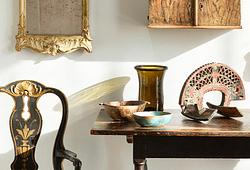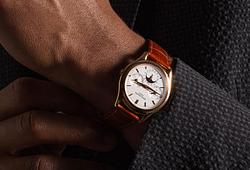Ola Billgren
"Providence"
Signed Ola Billgren and dated 1987 on verso. Canvas 157 x 152 cm.
Provenance
Acquired from the artist.
Exhibitions
Östergötlands länsmuseum, Bohusläns museum, Bildmuseet i Umeå och Jönköpings läns museum/konstförening, "Landskap med torn", 1994-1995.
Literature
Östergötlands länsmuseums förlag och författarna, "Landskap med torn", exhibition catalogue, 1986, illustrated p. 15.
More information
Ola Billgren was the first Swedish artist to clearly formulate the relationship between art as language and reality. He has been called both a theorist and a sensualist and his work captures the historical and the contemporary in one and the same picture. Billgren’s paintings are characterized by duality and ambiguity, both in terms of expression and content, and the dreamy presence is unmistakable, from his photorealistic works of the 1960s to the romantic touches of his later-period painting.
In the introduction to the catalogue for the exhibition “Ola Billgren - Landscape with Towers”, the artist describes his selection of works from 1983-93 as specifically composed from a close-up perspective. The selection can be divided into three subjects, all typical for the artist: the Spanish landscape, the landscapes of southern Sweden, and iconized projections of people he knows.
The painting in the auction, “Providence”, falls under the third category. As the title suggests, the portrait aims to convey reflection, long-term thinking, wisdom, and foresight. The portrait is based on a black-and white photograph, but the red field on the right-hand side of the canvas breaks the realistic illusion. Later in the 1990s, the colour red would come to completely dominate the paintings, but in the portrait "Providence", the artist uses the colour to convey a sense of concentration, warmth, and providence.
Artist
Ola Billgren was born in 1940 in Copenhagen but based his career in Sweden. Billgren was self-taught, having only been trained by his parents Hans and Grete Billgren. Ola worked within the mediums of graphic art, watercolour, collage, photography, film, and scenography. He was also an author and culture critic. Known for his versatility, Billgren cultivated a relationship between art and reality in his work.
During the 1960s, he transitioned from abstract expressionism to photographic realism. Over time, his paintings evolved into a fusion of abstract and photorealistic styles, resulting in romantic landscapes where he examined the interplay of light and color. Forms dissolved, and colors were reduced to monochrome, single-colored surfaces that were richly worked and varied.
In the late 1980s, he returned to urban environments in large cityscapes, often painted from a high perspective but maintaining the impressionistic approach seen in his landscapes. Ola Billgren's influence on recent decades of art has been significant. His work is represented in institutions such as Musée National d'art Moderne Centre George Pompidou in Paris and Moderna Museet in Stockholm.

































